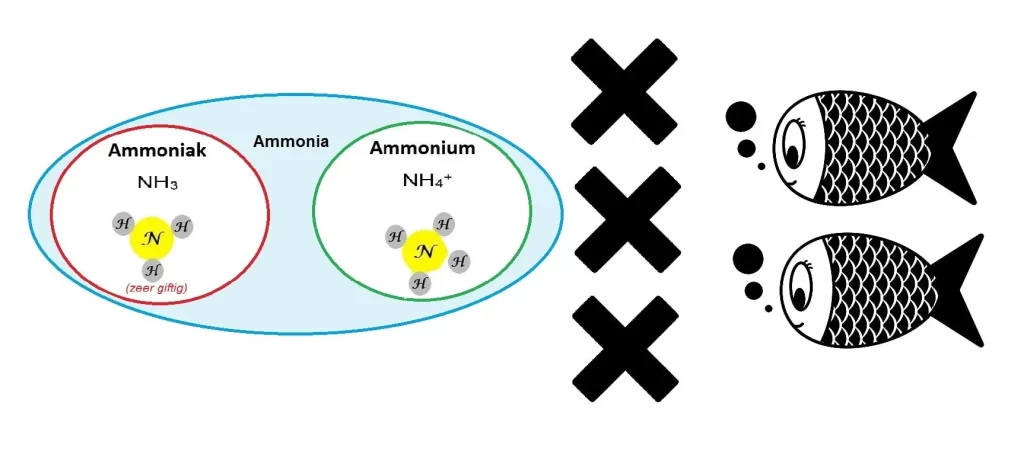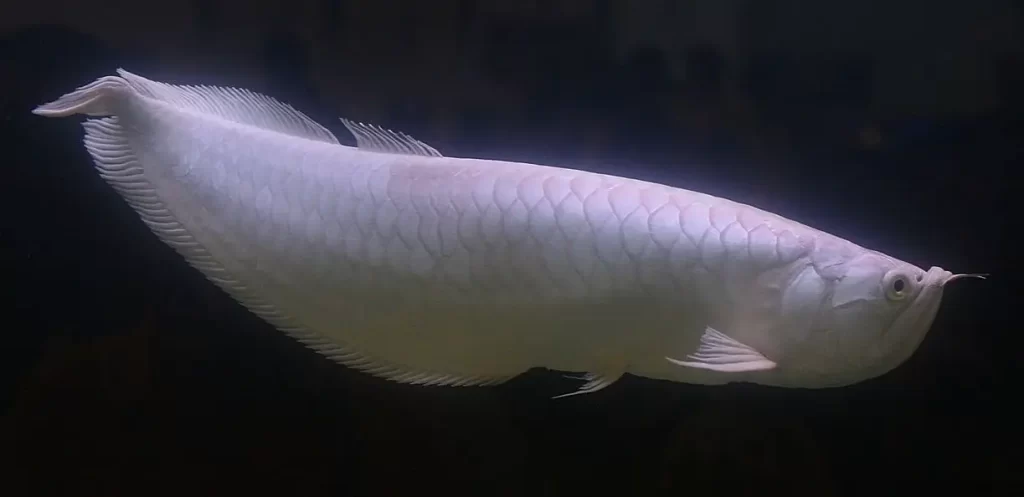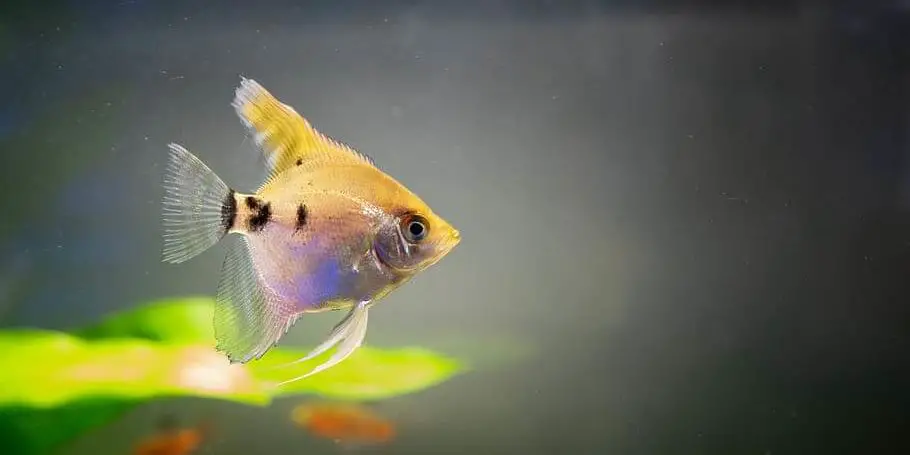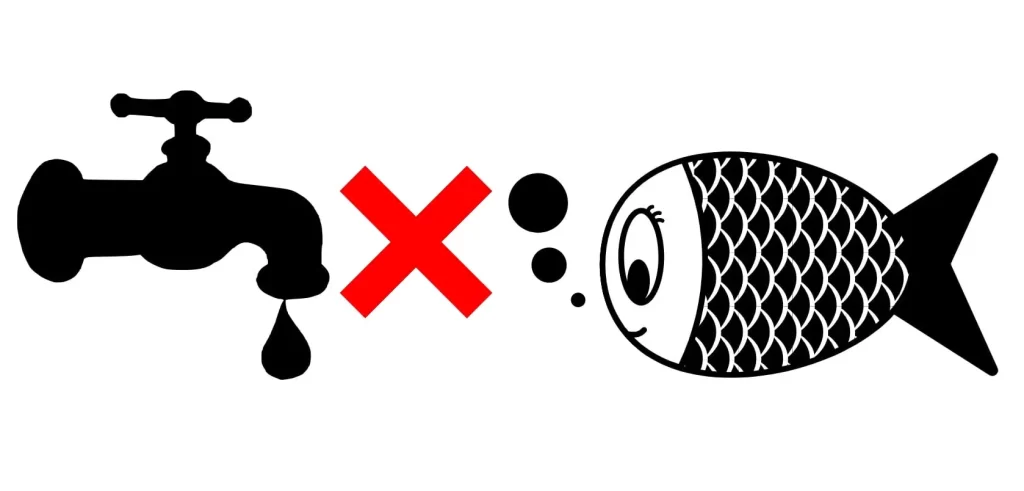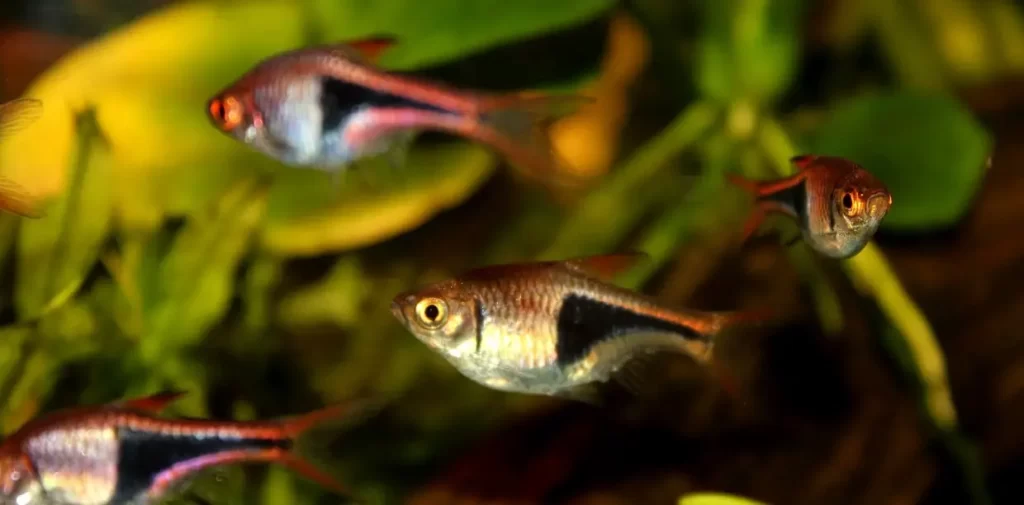Have you noticed your fish appearing a bit down or behaving differently than usual? One possible reason for this could be Ammonia Poisoning in your fish tank. It’s a condition where the level of harmful ammonia and related compounds in your aquarium increases, affecting the health of your fish.
Quick Answer:
Ammonia Poisoning doesn’t immediately cause fetal harm to your fish, but it can have serious long-term effects on their health if not treated promptly. The simplest way to address this issue is by regularly changing the water in your tank with ammonia-free water until the ammonia levels decrease to a safe level. It is important to closely monitor the ammonia levels in your tank, particularly during the initial stages of setting up your aquarium.
Don’t worry if you’re new to fish keeping, as it’s a common issue that can occur when you first set up your aquarium. By the end of this article, you will have a clear understanding of ammonia poisoning in your fish tank and some ways to eliminate it.
What Is Ammonia?
Ammonia is a chemical compound made up of nitrogen and hydrogen. It is an inorganic substance with alkaline properties, which means it can act as a base and react with acids. Ammonia is also corrosive and is a colorless gas with a pungent odor.
When ammonia is in its gaseous form, it can easily dissolve in water to create a solution called ammonium hydroxide. This solution is formed when ammonia molecules combine with water molecules. Ammonium hydroxide is commonly used in cleaning products and as a household cleaner.
However, it’s important to note that when ammonia or ammonium hydroxide is released into water streams, such as rivers or lakes, it can have harmful effects on aquatic life. The presence of ammonia in water can be toxic to fish and other aquatic organisms, and high concentrations can lead to their death.
What Is Ammonia Poisoning?
Let me explain what ammonia poisoning is. People often call it ammonia stress, but the term “ammonia poisoning” is usually used when a fish has already died from it.
Ammonia poisoning occurs when the level of ammonia in an aquarium becomes too high and starts to have negative effects on the aquatic life within it. This happens when the pH level of the aquarium increases, which disrupts the natural nitrogen cycle and triggers the ammonia level.
What Are The Causes Of Ammonia Poisoning?
Ammonia poisoning can be a serious problem in a fish tank, and it is caused by the accumulation of ammonia in the water. There are a few common causes of ammonia poisoning in aquariums that every fish keeper should be aware of. Some of the most common causes of ammonia poisoning are as follows:
1. New Tank Syndrome
Have you ever heard of “New Tank Syndrome”? It’s a common cause of ammonia poisoning in fish tanks. When you set up a new aquarium, it takes time for the tank to establish a stable nitrogen cycle. During this process, there can be a sudden spike in ammonia levels, which can lead to ammonia poisoning in your fish. To prevent this, it’s essential to properly cycle your tank before adding any fish. Ensuring the tank establishes a healthy nitrogen cycle helps you avoid the risks associated with New Tank Syndrome and provides a safe and stable environment for your fish.
2. Using Untreated Tap Water
When untreated tap water is added to an aquarium, especially if it contains chloramine, a chemical composed of chlorine and ammonia, it can cause a sudden increase in ammonia levels. The presence of chloramine in the water breaks down into ammonia, which can be detrimental to fish and other aquatic organisms.
That’s why it’s essential to treat the tap water before introducing it to the tank. Through the use of a water conditioner that neutralizes chloramine and ensures the water is safe for your aquatic pets, you can avoid potential harm caused by untreated tap water.
3. Inadequate Filtration System
Insufficient filtration is another frequent contributor to ammonia poisoning in fish tanks. When fish waste, leftover food, and organic debris decompose, they generate ammonia. An effective filtration system plays a crucial role in removing ammonia through the nitrogen cycle.
However, if the filtration system lacks sufficient power, it may struggle to keep up with the waste production, resulting in a hazardous accumulation of ammonia that can be toxic to fish.
4. Insufficient Beneficial Bacteria
Maintaining a clean and well-maintained aquarium is essential to secure a healthy aquatic environment. When left unattended, organic matter, like leftover food and waste, accumulates and serves as a food source for certain bacteria. These bacteria break down the organic matter, producing harmful substances such as ammonia into less harmful substances like Nitrate.
Failure to remove or reduce the waste and organic substances can lead to highly toxic ammonia levels in the tank, posing a grave danger to the fish and other underwater creatures. Regular cleaning, proper filtration, and water quality monitoring are vital for the well-being of your aquarium inhabitants.
5. Insufficient Water Changes
Not changing the water enough can cause a big problem for your fish tank: ammonia poisoning. You see, there are helpful bacteria in your tank that turn the ammonia into stuff that’s not as harmful. But these bacteria need oxygen and water flow to stay alive.
If you don’t change the water often, the ammonia can build up and the bacteria won’t be able to do their job. And that’s when your fish can get ammonia poisoning.
6. Overcrowding
Having too many fish in a tank can cause problems because they produce a lot of waste, which includes harmful ammonia. Ammonia can be toxic to fish and other aquatic creatures. It can also lead to the accumulation of other harmful substances, like nitrites and nitrates, in the water. To keep your fish safe, it’s critical to ensure that your tank is the right size for the number and size of fish you have.
7. Overfeeding
Feeding your fish too much can lead to high ammonia levels in your tank. When you give your fish more food than they need, they might not eat it all. And when that extra food breaks down, it produces more waste. This additional waste can raise ammonia levels and harm your fish.
To avoid overfeeding, make sure to give your fish the right amount of food based on their size and type. And if there’s any uneaten food, remove it from the tank right away.
8. pH Imbalance
If the pH level of the water in your tank is not balanced, it can impact the toxicity of ammonia. When the pH level is higher, it changes ammonia into a less harmful form called ammonium.
However, if the pH level is lower, it can lead to the release of more toxic ammonia gas. That’s why it’s essential to keep the pH level balanced in your tank. This helps to ensure the well-being and safety of your fish and other aquatic life.
9. Temperature Changes
You know, when the water in a fish tank gets too hot or too cold, it can make the fish feel uncomfortable and stressed out. This stress not only affects their overall well-being but also makes them more susceptible to getting ammonia poisoning, which can be harmful to their health.
To secure the best conditions for your fish, it’s super important to keep the water temperature consistent and within the right range. This helps to maintain their comfort and reduces the risk of stress-related health issues.
10. Medications
Some medications and treatments used to treat fish diseases can disturb the balance of helpful bacteria in the tank. This disruption can result in an increase in ammonia levels, which can be harmful to your fish.
That’s why it’s crucial to follow the instructions provided with any medications or treatments carefully. It’s also important to closely monitor the water quality during and after their use.
11. Fish Byproducts
When fish consume food, their bodies utilize protein to support growth and development. However, as a natural byproduct of this process, certain substances are produced and enter their bloodstream, eventually being released into the tank through their gills. This release of byproducts can contribute to an increase in the tank’s ammonia levels, which, if they become too high, can pose harm to the fish.
Symptoms Of Ammonia Poisoning/Ammonia Stress In Fish
Recognizing the symptoms of ammonia poisoning is important to prevent any fatal consequences for your fish. Let’s take a look at some common signs that you should be aware of:
1. Gasping For Breath
Fish that are exposed to high levels of ammonia in the water will experience difficulty breathing properly. As a result, they may start to gasp for breath, attempting to get more oxygen from the water. This is a clear indication that your fish are under stress or are experiencing ammonia poisoning.
2. Loss Of Appetite
When fish are exposed to high levels of ammonia, they may lose their appetite and stop eating or eat very little. This is a common symptom of ammonia poisoning, and it’s important to take action quickly to address the issue and prevent further harm to the fish.
3. Lethargy
Lethargy is another common symptom of ammonia poisoning in fish. When fish are exposed to high levels of ammonia, they may become weak and lose their normal activity level. They may swim less and spend more time resting or lying on the bottom of the tank. If you notice that your fish are not as active as they usually are, it may be a sign of ammonia poisoning.
4. Increased Mucus Production
Fish may produce more mucus than usual. This can be seen as a cloudy film on the fish’s body or the surface of the tank, and it’s a sign that the fish is experiencing stress or sickness due to ammonia poisoning.
5. Red Or Purple Gills
High levels of ammonia in the water can irritate the gills of fish, causing them to turn red or purple. This is because the gills are responsible for extracting oxygen from the water, and when they come into contact with high levels of ammonia, it can cause inflammation and damage to the gill tissue.
6. Bloody Patches On The Body
Fish may develop bloody patches on their body, which is an indication of internal damage caused by ammonia. If you notice any such signs, it is crucial to take immediate action to improve the water quality in the tank and minimize further harm to the fish.
7. Laying At The Bottom Of The Tank
Most of the time fish keep on swimming at the top or middle of the tank. But, if you see them spending more time resting at the bottom of the tank, on plants or other objects this is a sign of ammonia poisoning. This can be a sign that they are not feeling well and may be suffering from ammonia poisoning.
8. Death
If you do not take action over the unusual signs and symptoms of ammonia poisoning, it can have fatal consequences for fish and other aquatic animals. That’s why it’s crucial to regularly check the ammonia levels in your tank and take action to prevent or treat ammonia poisoning on time.
How Can I Detect Ammonia In My Tank Quickly And Accurately?
Ammonia remains invisible to the naked eye, making it difficult to detect unless it reaches a fatal level or fish exhibit signs of distress. So, detecting ammonia quickly and accurately is essential to prevent ammonia toxicity. There are a few ways to detect ammonia levels in your fish tank accurately, some of the effective tips are as follows:
1. Test Kits
Let’s talk about test kits. They’re really handy when it comes to checking the ammonia level in your fish tank. You can easily find ammonia test kits at most pet stores and online. There are two types of test kits available: liquid-based and strip-based.
Liquid-based test kits are known for their accuracy and reliability, although they can take a bit longer to use.
On the other hand, strip-based test kits are quick and convenient, but they may not be as precise as liquid-based ones.
Some popular options include the API Freshwater Master Test Kit, Nutrafin Master Test Kit, Tetra EasyStrips 6-in-1 Test Strips, and more. These kits make it easy to check your tank’s ammonia level and take immediate action to keep your fish healthy and happy.
For the best results, carefully follow the instructions provided with your chosen kit. This way, you can ensure accurate readings of the ammonia level in your tank, helping you maintain a safe and thriving environment for your aquatic friends.
2. Electronic Testers
Let me tell you about another option to detect ammonia levels in your fish tank: electronic testers. These cool gadgets use probes to measure the ammonia levels and show the results on a digital screen. While electronic testers might be a bit more expensive than test kits, they provide fast and accurate readings. Some advanced models can even connect to your phone or computer, so you can keep track of your tank’s water quality over time. It’s a high-tech way to stay on top of your aquarium’s ammonia levels.
3. Smell
Have you ever noticed a strong and unpleasant odor in your fish tank? That smell could be a sign of high ammonia levels. Ammonia has a strong and unpleasant odor that can be quite challenging to handle. It can be a potential sign of high ammonia levels in your fish tank. Interestingly, using your sense of smell can be another way to detect ammonia. However, it’s important to note that this method may not be very accurate, as some fish naturally produce their odor.
Regardless of the detection method you choose, regularly testing the ammonia levels in your tank is crucial for the well-being of your aquatic pets. If you discover high ammonia levels, it’s vital to take immediate action to prevent any harm to your fish and other aquatic life.
Treatments For Ammonia Poisoning
To treat ammonia poisoning in a fish tank, it is important to take steps to reduce the levels of ammonia in the water and prevent it from reaching toxic levels. Here are some effective ways to treat ammonia poisoning:
1. Large Water Changes
Performing large water changes is a highly effective way to reduce ammonia levels in a fish tank. The process involves replacing a significant portion of the tank water with fresh and dechlorinated water.
With every water change, the concentration of ammonia in the tank will decrease as the new water dilutes the existing ammonia. The amount of water to be changed may vary, but it is usually recommended to change between 25-50% of the tank’s water, depending on the tank size and the ammonia levels.
2. Quarantine Fish Until Ammonia Settles
If you find high ammonia levels in your tank, you may need to move your fish to a separate tank called a quarantine tank. This will help you treat the main tank for ammonia without harming the fish. Once the ammonia levels have stabilized, you can return the fish to the main tank.
3. Stop Feeding Fish For Some Time
One way to lower the high ammonia levels in your tank is by cutting back on feeding your fish. Overfeeding can increase the production of ammonia, as uneaten food can break down and contribute to ammonia build-up. You can reduce the amount of food you give your fish for a short time and help to lower ammonia levels
4. Use A Water Conditioner
You can use a water conditioner that can detoxify ammonia by converting it into a less harmful form, such as ammonium. This can be a quick and effective solution to provide temporary relief from high ammonia levels. It’s important to note that water conditioners can only provide a temporary fix and should not be relied upon as the only treatment for ammonia poisoning.
5. Use An Ammonia-Neutralizing Filter Media
You can use filter media that are designed to neutralize ammonia. These media, such as activated carbon or zeolite, can be added to the tank’s filter or used in a separate filter. They work by trapping ammonia molecules and converting them into a less harmful form, reducing the overall ammonia levels in the water. It’s important to replace or recharge the filter media regularly to ensure its effectiveness in removing ammonia.
6. Add Live Plants
Adding live plants to your fish tank can be an effective way to reduce ammonia levels. The plants absorb ammonia as a nutrient for growth, which can help to create a more balanced and healthy environment for your fish. Also, plants can provide other benefits, such as oxygenation of the water and natural hiding places for your fish to explore.
7. Aeration With Compressed Air
Using aeration with compressed air is a simple and effective way to remove high concentrations of ammonium effectively. If you don’t have compressed air, you can still use an air pump by adjusting it to a high setting and using an air stone. The air pump, which is a device that pushes air, can create enough agitation in the water when combined with the air stone.
The agitation caused by the rising bubbles facilitates the exchange of gases, allowing oxygen from the air to dissolve into the water. This promotes the growth of beneficial bacteria that break down ammonia into less harmful substances. With continuous aeration using compressed air, the ammonia levels in the water will decrease, providing a healthier environment for the aquatic life in the aquarium.
8. Dilute Pure Oxygen
One treatment method for ammonia poisoning in a fish tank is diluting pure oxygen. While obtaining pure oxygen tanks from the market might not be safe for home use, you can create a DIY solution using hydrogen peroxide (H2O2) and a potato.
You have to do is cut the potato into small cubes, then take a bottle and place the potato cubes inside. Seal the bottle tightly, leaving only a small opening for the air hose or pipe to pass through.
The pipe should not extend to the bottom of the bottle. Next, pour the hydrogen peroxide liquid into the bottle. Seal the bottle tightly to create an airtight environment.
The reaction between the hydrogen peroxide and the potato will generate oxygen, which is then dispersed into the fish tank through the air stone or power filter. This helps counteract ammonia poisoning and creates a healthier environment for the fish.
9. Using Medications
Using medications can be a final option to treat high ammonia levels in a fish tank, but it’s important to keep in mind that medications may have potential side effects and may harm beneficial bacteria in the tank.
Therefore, it’s best to exhaust other options before resorting to medications. It’s also important to carefully follow the instructions on the medication and monitor the tank closely during and after treatment.
Preventions For Ammonia Poisoning In Fish Tanks
Rather than looking for medications after ammonia poisoning, it is easier to minimize the risk and prevent your fish from getting ill. So, here are some of the best ways to minimize the risk of ammonia poisoning in your fish tank:
1. Promote Beneficial Bacteria
Encouraging the growth of beneficial bacteria is one of the most effective ways to prevent ammonia poisoning in a fish tank. These bacteria can help break down harmful compounds like ammonia, converting them into less harmful forms. To promote the growth of beneficial bacteria, make sure to properly cycle your tank before adding fish, avoid over-cleaning your tank, and avoid using chemicals that can kill off these important bacteria.
2. Avoid Overstocking
To minimize the risk of ammonia poisoning, it’s important to avoid overstocking your fish tank. When setting up a new tank, start with only a few fish and wait until the tank has fully cycled before adding more. Even in an established tank, it’s best to add new fish gradually to avoid overloading the system with waste and causing ammonia levels to spike.
3. Feeding Fish Appropriately
Excess food can break down and release ammonia into the water. Feed your fish only what they can consume within a few minutes, and remove any uneaten food from the tank. It’s better to feed your fish small portions throughout the day rather than a large amount all at once.
4. Clean And Change the Water Regularly
Regularly cleaning and changing the water in your fish tank can help to prevent the buildup of harmful compounds like ammonia. You should change 25-50% of the water every day depending on the size of your tank and the number of fish you have. This eventually makes the tank look clean and healthy.
5. Use A High-Quality Filter
Invest in a good quality filter to ensure your tank is properly filtered and the water quality is maintained. A filter helps to remove harmful substances, such as ammonia, from the water, preventing them from accumulating and posing a threat to your fish. Make sure the filter is appropriately sized for your tank and follow the manufacturer’s instructions for cleaning and maintenance.
6. Monitor Ammonia Level
To ensure the safety of your fish, it’s a good idea to regularly test the water for ammonia. If it is quite impossible, you should test the water at least twice a month to catch any potential issues before they become serious. This can help you take proactive steps to prevent ammonia poisoning and maintain a healthy environment for your fish.
Frequently Asked Questions (FAQs)
Here are some of the frequently asked questions related to ammonia poisoning, they are as follows:
What Is A Safe Ammonia Level In A Fish Tank?
The safe level of ammonia in a fish tank is zero parts per million (ppm). Even a small amount of ammonia can be harmful to your fish. Some people may consider a level of 0.25 ppm to be safe, but it’s always best to aim for 0 ppm to ensure the safety of your fish. Even the slightest presence of ammonia in the water can damage your fish’s gills, which is extremely dangerous.
Can Ammonia Poisoning Be Fatal To Fish?
Yes, ammonia poisoning can be fatal for fish. This toxic compound can cause significant harm to a fish’s internal organs, particularly its gills and liver. When the concentration of ammonia in the tank becomes too high, it can result in suffocation, seizures, and ultimately, death. Therefore, it is essential to monitor the ammonia levels in your tank regularly and take the necessary steps to prevent ammonia spikes
Can Live Plants Help Reduce Ammonia Levels In A Fish Tank?
Live plants can play a significant role in reducing ammonia levels in a fish tank. As natural water purifiers, they can absorb and utilize ammonia as a nutrient for growth. This process is known as the nitrogen cycle, where beneficial bacteria convert ammonia to nitrite and then to nitrate, which can be used by plants to live and survive.
Do Ammonia Poisoning In Fish Tanks Affect Humans?
Ammonia poisoning in fish tanks does not directly affect humans, but it can be an indicator of poor water quality that may have negative health impacts. While high concentrations of ammonia in a small and poorly ventilated room with a fish tank may pose a risk to humans, this is unlikely in a well-maintained tank. It’s important to handle chemicals used to treat fish tanks with care, as some can be toxic to humans if ingested or inhaled.
Conclusion
Ammonia poisoning is a common problem in fish tanks and can be deadly for fish if not addressed promptly. Preventing ammonia poisoning in a fish tank requires regular maintenance and monitoring of water quality. This includes performing partial water changes, testing the water parameters, and maintaining a healthy biological filter. Overfeeding should also be avoided, as excess food can contribute to ammonia production.
In addition, adding live plants to the aquarium can help absorb excess nutrients and reduce the buildup of ammonia. Choosing the right fish species for the tank size and maintaining appropriate stocking levels can also help prevent ammonia buildup and its negative effects. If you have any further queries, do not hesitate to ask us. Stay in touch for more updates!

